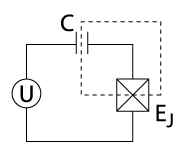Charge qubit

In
Typical
Fabrication
Charge qubits are fabricated using techniques similar to those used for
Hamiltonian
If the Josephson junction has a junction capacitance , and the gate capacitor , then the charging (Coulomb) energy of one Cooper pair is:
If denotes the number of excess Cooper pairs in the island (i.e. its net charge is ), then the Hamiltonian is:[4]
where is a control parameter known as effective offset charge ( is the gate voltage), and the Josephson energy of the tunneling junction.
At low temperature and low gate voltage, one can limit the analysis to only the lowest and states, and therefore obtain a two-level quantum system (a.k.a. qubit).
Note that some recent papers[8][9] adopt a different notation, and define the charging energy as that of one electron:
and then the corresponding Hamiltonian is:
Benefits
To-date, the realizations of qubits that have had the most success are ion traps and NMR, with Shor's algorithm even being implemented using NMR.[10] However, it is hard to see these two methods being scaled to the hundreds, thousands, or millions of qubits necessary to create a quantum computer. Solid-state representations of qubits are much more easily scalable, but they themselves have their own problem: decoherence. Superconductors, however, have the advantage of being more easily scaled, and they are more coherent than normal solid-state systems.[10]
Experimental progresses
The implementation of Superconducting charge qubits have been progressing quickly since 1996. Design was theoretically described in 1997 by Shnirman,
References
- S2CID 250887469.
- S2CID 4392755.
- PMID 12570573.
- ^ S2CID 6687697.
- S2CID 27305073.
- S2CID 19296685.
- ^ C. Rigetti et al., "Superconducting qubit in waveguide cavity with coherence time approaching 0.1 ms," arXiv:1202.5533 (2012)
- S2CID 118921729.
- S2CID 119181860.
- ^ a b Superconducting Charge Qubits, by Denzil Anthony Rodrigues, page 3
- S2CID 15467259.
- ^ Vincent Bouchiat (21 February 1997). Quantum Coherence of the Charge in a single-Cooper-pair box circuit (PDF) (PhD). Paris 6 University.
- S2CID 4392755.
- S2CID 43515935.






![{\displaystyle H=\sum _{n}{\big [}E_{\rm {C}}(n-n_{\rm {g}})^{2}|n\rangle \langle n|-{\frac {1}{2}}E_{\rm {J}}(|n\rangle \langle n+1|+|n+1\rangle \langle n|){\big ]},}](https://wikimedia.org/api/rest_v1/media/math/render/svg/f30900c7e806d9ef2845a74f9002f8e5a007f0c8)






![{\displaystyle H=\sum _{n}{\big [}4E_{\rm {C}}(n-n_{\rm {g}})^{2}|n\rangle \langle n|-{\frac {1}{2}}E_{\rm {J}}(|n\rangle \langle n+1|+|n+1\rangle \langle n|){\big ]}.}](https://wikimedia.org/api/rest_v1/media/math/render/svg/087ead1ff3d84254a8c2f820034493c161617b64)